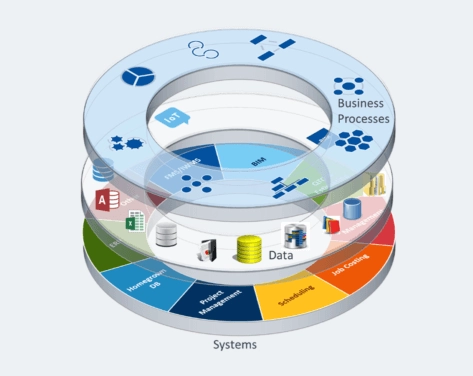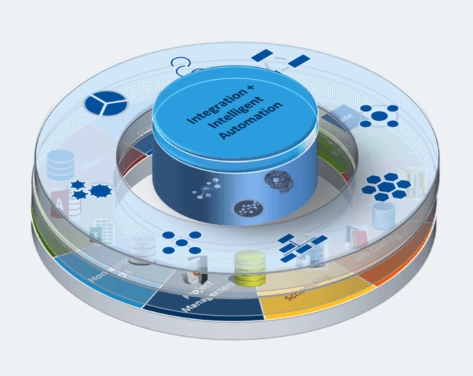Inconsistent data is not an issue that is specific to the construction industry. It’s a common problem that persists in every industry, new and old. The most common data issues that data experts focus on can be attributed to three elements: systems, data and processes. Here are brief explanations of issues with each of those elements:
- Systems: Myriad systems exist that are largely exceptional at solving the problem at hand, such as design systems, scheduling systems, project management systems, asset management systems, estimating systems, bid management systems, etc. But these systems do not “talk” to each other since each system is developed to solve specific problems and not to look at data as the life blood across every company.
- Data: Data is siloed in various formats, not only in the systems mentioned above, but also in internal systems of records, which are often stored in individual machines in their own formats.
- Processes: Cross-system workflows are either manual or mostly non-existent. Since most systems are focused on solving a particular business problem, the business processes for those systems are designed to be either one-off or constrained to the same system.

This graphic depicts the myriad, disconnected data sources already present in the construction industry grouped into three main elements: business processes, systems and data files. While some sources on the same ring may communicate with one another (though most often, they do not), sources on different rings do not.
There is, however, another data issue that persists that a lot of data experts miss, and it’s the one I would call the fourth, and most important, element. That is interoperability, and issues arise when the data that exists is not interoperable. A lot of data gurus promote the value of quality data, but without interoperability, System A may call an item “X” while System B calls the item “Y.”
It’s not simply that systems are not built to communicate with each other. It’s that each system is often speaking its own language and may misinterpret data coming from another system. This inconsistency creates problems. Both “X” and “Y” may be quality data within the context of a user or a system; but quality does not equate to accuracy, and hence the data is not trusted. To put it simply, quality and accuracy have a direct correlation to interoperability.
Want to hear more about what the future of construction might look like? Check out this free, on-demand webinar with two of Gordian’s foremost industry experts, including the author of this post.
To have interoperable data, standards are needed to define how systems talk to each other. Such standards are almost non-existent in the construction industry, and the few that exist are insufficient or inconsistent. Other industries beset by this same issue have been forced to adopt standard ways of cross-industry communications. Such cross-industry communication standards slowly made their way into the internal systems of companies, structuring them in a way as to enable cross-system communications within the company. But, so far, the construction industry has yet to catch up.
So why is this such a big issue? Let’s look at the downstream implications of inconsistent data.
Impacts of inconsistent data in construction
Here are four key consequences the industry is facing because of its data issues:
- Inaccurate project prioritization
- Lack of visibility into planning and project selection processes
- Incomplete or misinterpreted project scopes
- Inaccurate estimates
All of those consequences add up, and not just figuratively. Poor communication and poor project data collectively accounted for a total of $31.3 billion in rework in 2018 for the U.S. construction industry.
The emergence of new technologies has also compounded the problem, and innovation in the construction industry is increasing data inconsistency at an exponential pace. The current pandemic caused havoc to the construction industry, but it is also enabling innovative solutions such as sensors to maintain social distancing, increased use of robotics, IoT sensors, virtual reality, etc. Such new systems will add additional burden to the already complex data ecosystem, potentially adding more issues in the future.
Poor communication and poor project data collectively accounted for a total of $31.3 billion in rework in 2018 for the U.S. construction industry.
Where do we go from here?
The construction industry, including its software and hardware vendors, need to come together to establish common standards, common vocabulary and language. In addition, the core gap that exists today should be tackled through established data and content providers. Companies should invest in integration of trusted data between various systems, data sources and processes. If all the systems talk together with trusted data at their center, issues that we currently see due to poor communications will be reduced.
This graphic depicts an ideal future state, where a common data language and data interpretation tools create fluid movement from one data source to another.
What does the future hold?
Artificial Intelligence and data analytics technologies are making a huge impact in many industries, allowing companies to leapfrog competition while gaining operational savings. And, the key to the successful adoption of such innovative technology is data! If the data used is not trusted or not interoperable, implementing these technologies will be extremely difficult, and, in many cases, the technology’s potential will not be fully realized.
Successfully realizing the potential of new technologies is dependent on consistent data and an established information architecture.
It is a foregone conclusion that such technologies will make their way into the construction industry. Many believe AI and data analytics is the future and the potential benefits of adopting them are enormous. But successfully realizing the potential of new technologies is dependent on consistent data and established information architecture.






